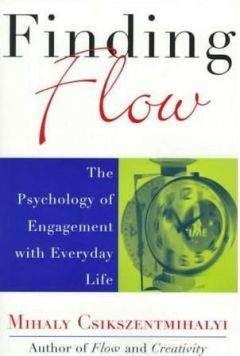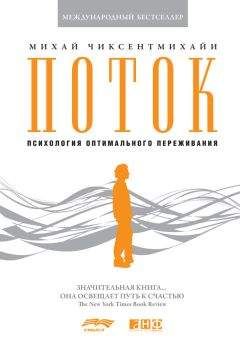Csikszentmihalyi, М., and R. Larson. 1978. Intrinsic rewards in schoolcrime. Crime and Delinquency 24: 322-35.
—. (1984). Being adolescent: Conflict and growth in the teenage years. New York: Basic Books.
Csikszentmihalyi, М., R. Larson, and S. Prescott. 1977. The ecology of adolescent activities and experiences. Journal of Youth and Adolescence 6: 281-94.
Csikszentmihalyi, М., and J. LeFevre. 1989. Optimal experience in work and leisure. Journal of Personality and Social Psychology 56 (no.5): 815-22.
Csikszentmihalyi, М., and F. Massimini. 1985. On the psychological selection of bio-cultural information. New Ideas in Psychology 3(no.2): 115-38.
Csikszentmihalyi, М., and K. Rathunde. 1990. The psychology of wisdom: An evolutionary interpretation. In Wisdom: Its nature, origins, and development, ed. R.J. Sternberg, 25–51. New York: Cambridge University Press.
Csikszentmihalyi, М., К. Rathunde, and S. Whalen. 1993. Talented teenagers: A longitudinal study of their development. New York: Cambridge University Press.
Csikszentmihalyi, М., and R. Robinson. 1990. The art of seeing. Malibu, Calif.: J. P. Getty Press.
Csikszentmihalyi, М., and E. Rochberg-Halton. 1981. The meaning of things: Domestic symbols and the self. New York: Cambridge University Press.
Csikszentmihalyi, М., and U. Schiefele. 1992. Arts education, human development, and the quality of experience. In Arts in Education: The 91st yearbook of the Society for the Study of Education, ed. G. Reimer and R. A. Smith, 169-91. Chicago: University of Chicago Press.
Damon, W. 1983. Social and personality development. New York: W.W. Norton.
Davis, F. D., R. P. Bagozzi, and P. R. Warshaw. 1989. Usefulness versus fun as determinants of intentions to use computers in the workplace. Working paper. Ann Arbor, Mich.: University of Michigan Press.
Dawkins, R. 1976. The selfish gene. Oxford: Oxford University Press.
—. 1982. The extended phenotype. Oxford: Oxford University Press.
deCharms, R. 1968. Personal causation: The internal affective determinants of behavior. New York: Academic Press.
Deci, E. L., and R. M. Ryan. 1985. Intrinsic motivation and self-determination in human behavior. New York: Plenum Press.
Delle Fave, A., and F. Massimini. 1988. Modernization and the changing contexts of flow in work and leisure. In Optimal experience: Studies of flow in consciousness, ed. M. Csikszentmihalyi and I. S. Csikszentmihalyi, 193–213. New York: N Cambridge University Press.
—. 1992. The ESM and the measurement of clinical change: A case of anxiety disorder. In The experience of psychopathology, ed. M. deVries, 280-89, Cambridge: Cambridge University Press.
Dennett, D. C. 1991. Consciousness explained. Boston: Little, Brown.
deVries, М., ed. 1992. The experience of psychopathology: Investigating mental disorders in their natural settings. Cambridge: Cambridge University Press.
Dewey, J. 1913. Interest and effort in education. Cambridge: The Riverside Press.
Diamond, J. 1992. The third chimpanzee. New York: HarperCol-lins. Didion, J. 1989. Letter from Los Angeles. The New Yorker (24 April): 88–99.
Dobzhansky, T. 1937. Genetics and the origin of species. New York: Columbia University Press.
Donaldson, M. 1993. Human minds: An exploration. New York: Viking.
Donner, E., and M. Csikszentmihalyi. 1992. Transforming stress to flow. Executive Excellence 9 (no. 2): 16–18.
Douglas, М. 1966. Purity and danger. London: Routledge and Kegan Paul.
Dozier, R. W.,Jr. 1992. Codes of evolution. New York: Crown Publishers.
Dreyfus, H. 1979. What computers can’t do: The limits of artificial intelligence. 2d ed. New York: Harper & Row.
Dubs, H. H. 1928. The works ofHsuntze. London.
Durkheim, E. [1912] 1967. The elementary forms of religious life. New York: The Free Press.
Edelman, G. M. 1993. Bright air, brilliantfire: On the matter of the mind. New York: Basic Books.
Ellis, J. 1986. The social history of the machine gun. Baltimore, Md.: The Johns Hopkins University Press.
Eno, R. 1990. The Confucian creation of heaven. Albany, N. Y.: State University of New York Press.
Erikson, E. H. 1950. Childhood and society. New York: W.W. Norton.
Esslin, M. 1976. Aristotle and the advertisers: The television commercial considered as a form of drama. In Television: The critical view, ed. N. Newcomb. New York: Oxford University Press.
Evans, D. 1991. The war that Japan is winning. Chicago Tribune, 6 December.
Evans-Pritchard, E. E. [1956] 1974. Nuer religion. New York: Oxford University Press.
Faludy, G. 1988. Test es leek. Budapest: Magyar Vilag Kiado.
—. 1989. Bortonversek 1950-53. Budapest: Magyar Vilag Kiado.
Fay, B. 1966. Louis XVI, ou la Jin d’un monde. Paris: Librairie Academique Perrin.
Fel, E., and T. HofFer. 1969. Proper peasants: Traditional life in a Hungarian village. Viking Fund Publication no. 46. Chicago: Wenner-Gren Foundation.
Ferenczi, S. 1950. Sunday neuroses. In Further contributions to the theory and technique of psychoanalysis, ed. S. Ferenczi, 174-77. London: Hogarth Press.
Fine, R. 1956. Chess and chess masters. Psychoanalysis 3:7-77.
Fingarette, Н. 1979. The problem of the self in the Analects. Philosophy East and West 29 (no. 2): 129-40.
Fisher, S. 1970. Body experience in fantasy and behavior. New York: Appleton-Century-Crofts.
Fiske, D. W., and S.R. Maddi, eds. 1961. Functions of varied experience. Homewood, 111.: Dorsey Press.
Fowler, J. W. 1981. Stages of faith. New York: Harper & Row.
Frazer, J. G. [1890] 1959. The golden bough: A study in magic and religion.
Freedberg, D. 1989. The power of images: Studies in the history and theory of response. Chicago: University of Chicago Press.
Gardner, H. 1983. Frames of mind. New York: Basic Books.
—. 1993. Creating minds. New York: Basic Books.
Geiger, K. 1968. The family in Soviet Russia. Cambridge, Mass.: Harvard University Press.
Getzels, J. W., and M. Csikszentmihalyi. 1976. The aeative vision: A longitudinal study of problem finding in art. New York: Wiley Inter-science.
Ghani, J. A. 1990. Flow in human-computer interactions: Test of a model. Unpub. Mscrpt. San Francisco: National Academy of Management Meeting.
Gilligan, C. 1982. In a different voice. Cambridge, Mass.: Harvard University Press.
Gilligan, C, J.V. Ward, and J.M. Taylor. 1988. Mapping the moral domain: A contribution of women’s thinking to psychological theory and education. Cambridge, Mass.: Harvard University Press.
Goertzel, V., and M. G. Goertzel. 1962. Cradles of eminence. Boston: Little, Brown.
Goffman, E. 1979. Gender advertisements. New York: Harper & Row. Granet, M. 1934. Lapensie chinoise. Paris: F. Alcan.
Grinstein, A. 1955. Vacations — a psychoanalytic study. Inter-nationaUournal of Psychoanalysis 36:177-86. Group for the Advancement of Psychiatry. (1958, August). ‘Vhepsychiatrist’s interest in leisure-time activities. (Report #39.) New York: Author.
Hauser, А. 1951. Tlie social history of art. New York: Alfred A. Knopf.
Hebb, D. O. 1955. Drive and the CNS. Psychological Review (July): 243-52.
Heidegger, M. 1962. Being and time. New York: Harper & Row. Helmer, W. J. 1970. Tlie gun that made the twenties roar. New York: Macmillan.
Hitti, P. K. 1970. TIk Arabs: A short history. Chicago: Gateway.
Hofstadter, D. R., and D. C. Dennett. 1981. ‘Hie mind’s I: Fantasies and reflections on self and soul. New York: Basic books.
Hollis, C. I960. Eton, a history. London.
Howe, J. R., Jr. 1966. The changing political thought of John Adams. Princeton, N. J.: Princeton University Press.
Hubbard, W. 1677. Narrative of the trouble with the Indians in New England. Quoted in G. Carruth (1989) Wliat Happened Mien (p. 20). New York: Harper & Row.
Huizinga, J. [1939] 1970. Homo ludens: A study of the play element in culture. New York: Harper & Row.
— 1954. TliewaningoftheMiddleAges. Garden City, N. Y.: Double— day.
Hulme, W. 1977. Human potential in the Lutheran Church. Dialog 16: 266.
Huxley, A. 1967. Island. New York: Bantam Books.
Ikeda, D. 1988. Unlocking the mysteries of life and death: Buddhism in the contemporary world. London: Macdonald.
Ivanhoe, P. J. 1991. A happy symmetry: Xunzi’s [Hsiin-tzu’s] ethical thought. Journal of the American Academy of Religion 59 (no. 2): 309-22.
Jackson, S. 1992. Athletes in flow: A qualitative investigation of flow states in elite figure skaters. Journal of Applied Sports Psychology 4(no.2): 161-80.
James, W. 1890. Principles of psychology. Vol. 1. New York: Henry Holt.
Jaspers, K. [1923] 1963. General psychopathology. Chicago: University of Chicago Press.
—. 1969. Nietzsche. Chicago: Henry Regnery.
Jaynes, J. 1977. Tlie origin of consciousness in the breakdown of the bicameral mind. Boston: Houghton Mifflin.
Jhally, S. 1990. The codes of advertising: Fetishism and the political economy of meaning in the consumer society. New York: Rout-ledge.
Johnson, C, and R. Larson. 1982. Bulimia: An analysis of moods and behavior. Psychosomatic Medicine 44: 341-51.
Jones, E. 1931. The problem of Paul Morphy. International Journal of Psychoanalysis 12: 1-23.
Kauffman, S. A. 1993. The origins of order: Self-organization and selection in evolution. New York: Oxford University Press.
Kavanaugh, J. 1981. Following Christ in a consumer society. New York: Orbis.
Kaye, K. 1977. Toward the origin of dialogue. In Studies in mother-infant interaction, ed. H.R. Schaffer. New York: Academic Press.
Keen, S. 1982. Self-love and the cosmic connection. In The holographic paradigm, ed. K. Wilber, 117. Boulder, Colo.: Shambala.
Kegan, R. 1982. 77ic evolving self. Cambridge, Mass.: Harvard University Press.
Keightley, D. N. 1978. The sources of Shang history: Tlie oracle-bone inscriptions of bronze-age China. Berkeley: University of California Press.
Kelly. J. 1982. Leisure. Englewood Cliffs, N. J.: Prentice-Hall.
Klausner, S. Z. 1965. The quest for self-control. New York: The Free Press.
Kobasa, S. C. 1979. Stressful life events, personality, and health: An inquiry into hardiness. Journal of Personality and Social Psychology 37 (no. 1): 1-11.
Koestler, A. 1960. Tlie lotus and robot. London: Hutchinson.
Kohlberg, L. 1984. Essays on moral development. Vol. 2, Tlie psychology of moral development. San Francisco: Harper & Row.
Konner, M. 1990. Human nature and culture: Biology and the residue of uniqueness. In Tlie Boundaries of Humanity, ed. J. J. Sheehan and M. Sosna, 103-24. Berkeley: University of California Press.
—. 1991. Childhood, Boston: Little, Brown.
Kovi, P. 1985. Transylvanian cuisine. New York: Crown Publishers.
Kubey, R., and M. Csikszentmihalyi. 1990. Television and the quality of life: How viewing shapes everyday experience. Hillsdale, N. J.: Lawrence Erlbaum.
Kuhn, T. S. 1962. The structure of scientific revolutions. Chicago: University of Chicago Press.
Kummer, H. 1968. Social organization of hamadryas baboons. Chicago: University of Chicago Press.
Lancaster, B. 1991. Mind, brain and human potential: The quest for an understanding of self. Rockport, Mass.: Element.
Lang, G. 1971. The cuisine of Hungary. New York: Atheneum.
Lantemari, V. 1965. The religions of the oppressed: A study of modem messianic cults. New York: Mentor Books.
Latourette, K. S. [1946] 1970. A short history of the Far East. New York: Macmillan.
—. 1959. The Chinese: Their history and culture. New York: Macmillan.
Lau, D. C. 1953. Theories of human nature in Mencius and Shyntzy. Bulletin of the School of Oriental and African Studies 15: 541-65.
Lavin, M. A. 1990. The place of narrative. Chicago: University of Chicago Press.
Lazarus, R. S. 1966. Psychological stress and the coping process. New York: McGraw-Hill.
Lazarus, R. S., and S. Folkman. 1984. Stress, appraisal, and coping. New York: Springer.
Lefebvre des Noettes, M. 1931. L’attelage et le cheval de selle a travers les ages. Paris: Presse Universitaire de France.
—. 1932. Le gouvernail: Contribution a l’histoire de l’esclavage. Memoires de la Societe des Antiquaires de France 78: 712-45.
Lepper, M. R., and D. Greene, eds. The hidden costs of reward: New perspectives on the psychology of human motivation. Hillsdale, N. J.: Lawrence Erlbaum.
LeVine, R. A. 1979. Adulthood among the Gusii. In Themes of work and love in adulthood, ed. N. Smelser and E. Erikson, 77-104. Cambridge, Mass.: Harvard University Press.
LeVine, R. A., and D. T. Campbell. 1972. Ethnocentrism: Theories of conflict, ethnic attitudes, and group behavior. New York: Wiley.





